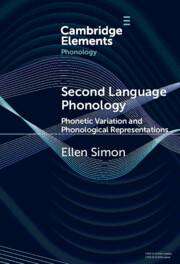363 results

Second Language Phonology
- Phonetic Variation and Phonological Representations
-
- Published online:
- 20 March 2025
- Print publication:
- 27 March 2025
-
- Element
-
- You have access
- HTML
- Export citation
Chapter 10 - Continuous Cycles of Perceiving, Acting, and Adjusting
- from Part II - Psychological Theories
-
- Book:
- Looking Ahead
- Published online:
- 20 March 2025
- Print publication:
- 06 March 2025, pp 98-111
-
- Chapter
- Export citation
5 - Station Rhythm Enskilment
-
- Book:
- Bus Station Hustle
- Published online:
- 09 February 2025
- Print publication:
- 13 February 2025, pp 92-113
-
- Chapter
-
- You have access
- Open access
- HTML
- Export citation
Chapter Two - Brain Mechanisms of Aging
-
- Book:
- Cognitive and Social Neuroscience of Aging
- Published online:
- 14 February 2025
- Print publication:
- 13 February 2025, pp 23-54
-
- Chapter
- Export citation

Constructing Experience
- Expectation and Attention in Perception
-
- Published online:
- 30 January 2025
- Print publication:
- 30 January 2025
-
- Element
- Export citation
15 - The Decay of the Epistemological Norm of Political Visibility
- from Part IV - The Erosion of the Epistemological Constitution of Modern Democracy
-
- Book:
- Can Democracy Recover?
- Published online:
- 02 January 2025
- Print publication:
- 16 January 2025, pp 150-152
-
- Chapter
- Export citation
Locke on the Molyneux Question: A Sensible Point View
-
- Journal:
- Canadian Journal of Philosophy , FirstView
- Published online by Cambridge University Press:
- 13 January 2025, pp. 1-13
-
- Article
-
- You have access
- Open access
- HTML
- Export citation
Models for the Statistics and Mechanisms of Response Speed and Accuracy
-
- Journal:
- Psychometrika / Volume 70 / Issue 2 / June 2005
- Published online by Cambridge University Press:
- 01 January 2025, pp. 383-388
-
- Article
- Export citation
7 - Communication and Cognition
-
- Book:
- Elephants
- Published online:
- 12 December 2024
- Print publication:
- 19 December 2024, pp 165-210
-
- Chapter
- Export citation
What Perceptualists Can Say About Reasons for Emotion
-
- Journal:
- Canadian Journal of Philosophy / Volume 53 / Issue 6 / August 2023
- Published online by Cambridge University Press:
- 18 December 2024, pp. 502-518
-
- Article
-
- You have access
- Open access
- HTML
- Export citation
2 - Selective Perception
- from Part I - Understanding Groups
-
- Book:
- Groups
- Published online:
- 12 December 2024
- Print publication:
- 05 December 2024, pp 24-42
-
- Chapter
- Export citation
Chapter 10 - Collingwood on Imagination
- from Part II - Issues in Collingwood’s Philosophy
-
-
- Book:
- Interpreting R. G. Collingwood
- Published online:
- 22 November 2024
- Print publication:
- 05 December 2024, pp 184-203
-
- Chapter
- Export citation
Chapter 15 - Twentieth- and Twenty-First-Century Theatre Directing
-
-
- Book:
- A New History of Theatre in France
- Published online:
- 22 October 2024
- Print publication:
- 21 November 2024, pp 294-311
-
- Chapter
- Export citation
35 - Bridging the Gap between Bilingual Phonetic Research and Pronunciation Teaching
- from Part VI - Variables and Outcomes of Bilingual Speech
-
-
- Book:
- The Cambridge Handbook of Bilingual Phonetics and Phonology
- Published online:
- 14 November 2024
- Print publication:
- 21 November 2024, pp 791-812
-
- Chapter
- Export citation
8 - There Is Only One World
- from Part III - Intellect
-
- Book:
- Plotinus on the Contemplation of the Intelligible World
- Published online:
- 03 September 2024
- Print publication:
- 21 November 2024, pp 294-318
-
- Chapter
- Export citation
3 - The Beautiful Face of Justice
- from Part II - Soul
-
- Book:
- Plotinus on the Contemplation of the Intelligible World
- Published online:
- 03 September 2024
- Print publication:
- 21 November 2024, pp 91-141
-
- Chapter
- Export citation
3 - On Clare’s Translation of Perception to Poetry
- from Part I - Clare the Poet
-
-
- Book:
- The Cambridge Companion to John Clare
- Published online:
- 14 November 2024
- Print publication:
- 21 November 2024, pp 46-59
-
- Chapter
- Export citation

The Theological Imagination
- Perception and Interpretation in Life, Art, and Faith
-
- Published online:
- 09 November 2024
- Print publication:
- 07 November 2024
1 - Introduction
-
- Book:
- The Theological Imagination
- Published online:
- 09 November 2024
- Print publication:
- 07 November 2024, pp 1-36
-
- Chapter
-
- You have access
- HTML
- Export citation
3 - Bearing Ambiguity
-
- Book:
- The Theological Imagination
- Published online:
- 09 November 2024
- Print publication:
- 07 November 2024, pp 67-104
-
- Chapter
- Export citation


